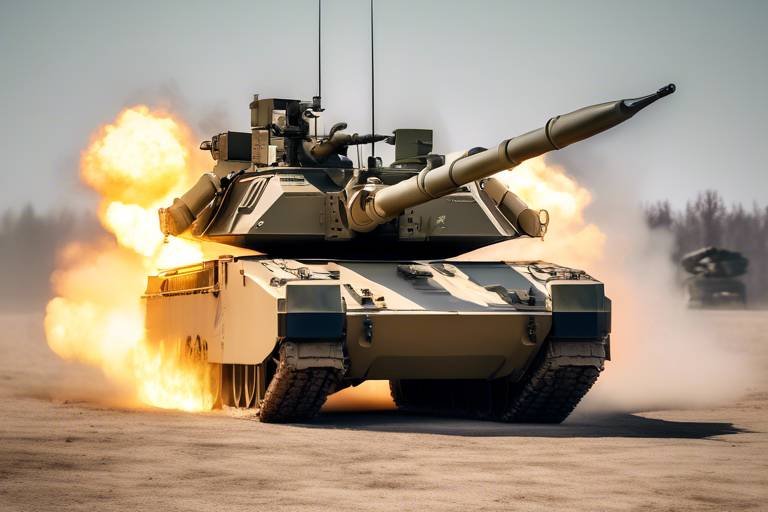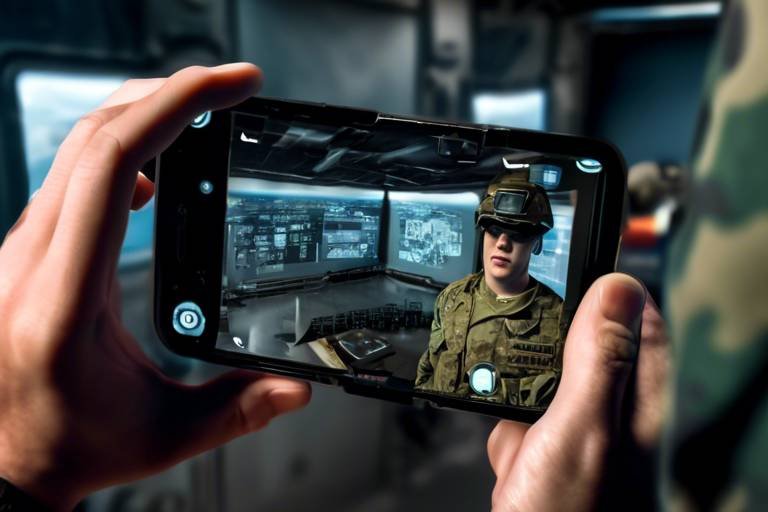The Role of AI in Monitoring Military Infrastructure
Artificial Intelligence (AI) is no longer just a concept from science fiction; it has become a pivotal force in reshaping various sectors, including the military. This article explores the transformative impact of AI on military infrastructure monitoring, highlighting advancements, applications, challenges, and future prospects. Imagine a world where military operations run seamlessly, where data is processed at lightning speed, and where threats are detected before they even materialize. Sounds like a dream, right? Well, with AI, this dream is becoming a reality.
In the realm of military infrastructure, the integration of AI technologies is revolutionizing how operations are conducted. Traditional methods of monitoring and surveillance are often reactive, responding to incidents after they occur. However, with AI, the focus shifts to a proactive approach. This means that military personnel can foresee potential issues, allocate resources more effectively, and enhance overall operational readiness. The importance of AI in this context cannot be overstated, as it not only improves efficiency but also significantly reduces risks associated with human error and oversight.
As we delve deeper into the various AI technologies employed in military surveillance, it's essential to recognize that this is a multifaceted landscape. From machine learning algorithms that analyze patterns in data to advanced robotics that perform reconnaissance missions, AI is at the forefront of modern military strategy. The integration of these technologies allows for a more comprehensive understanding of the battlefield, enabling commanders to make informed decisions swiftly.
Moreover, the benefits of AI integration extend beyond mere surveillance. The ability to analyze vast amounts of data in real-time offers military operations unparalleled advantages. For instance, AI-driven analytics can process information from various sources, such as satellite imagery, drone feeds, and ground sensors, creating a holistic view of the operational environment. This capability is akin to having a superpower—where military leaders can anticipate enemy movements and strategize accordingly.
However, as with any revolutionary technology, the implementation of AI in military infrastructure monitoring is not without its challenges. Data security emerges as a significant concern, given that sensitive information could be vulnerable to cyber-attacks. Additionally, ethical considerations surrounding the deployment of AI in military contexts raise questions about accountability and potential biases in decision-making processes. Addressing these issues is crucial to ensuring that AI is used responsibly and effectively.
Looking ahead, the future trends in military AI are promising. The integration of AI with the Internet of Things (IoT) is set to provide comprehensive monitoring solutions, enabling real-time data collection and analysis across military infrastructure. This synergy between AI and IoT will create a network of interconnected devices that can communicate and collaborate, further enhancing situational awareness and operational efficiency.
In conclusion, the role of AI in monitoring military infrastructure is transformative and multifaceted. While there are challenges to navigate, the potential benefits far outweigh the drawbacks. As we continue to explore this exciting frontier, it is vital to remain vigilant about the ethical implications and ensure that AI serves as a tool for peace and security, rather than a source of conflict. The journey is just beginning, and the possibilities are endless.
- What is the primary role of AI in military infrastructure monitoring?
AI enhances operational efficiency by providing real-time data analysis, predictive maintenance, and automated threat detection. - What are the benefits of integrating AI into military operations?
Benefits include improved data analysis, real-time monitoring, enhanced decision-making, and reduced operational costs. - What challenges does AI face in military applications?
Challenges include data security, ethical concerns, and the need for skilled personnel to manage AI systems. - How does AI integrate with IoT in military infrastructure?
AI and IoT integration allows for comprehensive monitoring solutions, enabling real-time data collection and enhanced situational awareness. - What ethical considerations are associated with AI in military use?
Ethical concerns include accountability, potential biases in decision-making, and the impact of AI on warfare dynamics.

AI Technologies in Military Surveillance
In the rapidly evolving landscape of military operations, artificial intelligence (AI) has emerged as a game-changer, particularly in the realm of surveillance. Understanding the various AI technologies utilized in military surveillance is crucial for enhancing operational efficiency and effectiveness. From image recognition systems that analyze aerial footage to predictive analytics that forecast potential threats, AI tools are reshaping how military forces monitor critical infrastructure and assets.
One of the most significant advancements in military surveillance is the use of computer vision. This technology enables systems to interpret and understand visual data from various sources, such as drones and satellite imagery. By employing sophisticated algorithms, military personnel can detect unusual patterns or movements that may indicate a security breach. For instance, a drone equipped with AI can autonomously survey a designated area, identifying and classifying objects in real time, which can be invaluable during reconnaissance missions.
Additionally, natural language processing (NLP) plays a pivotal role in analyzing vast amounts of textual data generated from intelligence reports, social media, and communications. By using NLP, military analysts can extract relevant information, identify trends, and even predict potential threats based on the sentiment and context of the data. This capability not only enhances situational awareness but also aids in making informed decisions quickly.
Moreover, the integration of machine learning algorithms allows military systems to continuously improve their surveillance capabilities. These systems can learn from past data and adapt to new threats, making them increasingly effective over time. For example, if a particular type of drone activity is detected frequently in a specific area, the AI can adjust its monitoring parameters to focus more on that behavior, ensuring that military forces are always one step ahead of potential adversaries.
Another exciting development is the use of autonomous systems in military surveillance. These systems can operate independently, conducting surveillance missions without direct human intervention. Equipped with AI, they can navigate complex environments, avoid obstacles, and even make decisions based on real-time data. This not only reduces the risk to human personnel but also increases the efficiency of surveillance operations, allowing for more extensive coverage with fewer resources.
As we delve deeper into the integration of AI in military surveillance, it's essential to acknowledge the impact of these technologies on overall military strategy. The ability to monitor vast areas in real time, coupled with advanced data analytics, provides military leaders with a comprehensive understanding of the battlefield. This level of insight is critical in making strategic decisions, allocating resources effectively, and ultimately ensuring the safety and success of military operations.
In conclusion, AI technologies are revolutionizing military surveillance by enhancing data analysis, improving threat detection, and enabling autonomous operations. As these technologies continue to evolve, they will undoubtedly play a crucial role in shaping the future of military infrastructure monitoring.
- What are the primary AI technologies used in military surveillance?
AI technologies include computer vision, natural language processing, machine learning, and autonomous systems, all of which enhance monitoring capabilities. - How does AI improve decision-making in military operations?
AI provides real-time data analysis and predictive insights, allowing military leaders to make informed decisions quickly and efficiently. - What are the ethical concerns surrounding AI in military applications?
Ethical concerns include accountability for AI decisions, potential biases in data interpretation, and the implications of autonomous systems in combat scenarios.

Benefits of AI Integration
The integration of artificial intelligence (AI) into military infrastructure monitoring is not just a trend; it's a game-changer. Imagine a world where military operations are not only faster but also smarter. With AI, this vision is becoming a reality. The benefits of AI integration are vast, transforming how military personnel approach surveillance and decision-making. One of the most significant advantages is the ability to analyze data at lightning speed. In an age where information is abundant, having the capability to sift through vast amounts of data quickly and accurately is invaluable. AI-driven systems can process this data, identifying patterns and anomalies that human analysts might miss. This leads to improved situational awareness and enables military leaders to make informed decisions in real-time.
Furthermore, AI enhances real-time monitoring capabilities. Traditional methods of surveillance often involve manual checks and human oversight, which can be time-consuming and prone to errors. AI systems can continuously monitor military installations and assets, providing alerts and insights that keep personnel informed about any potential threats or irregularities. This constant vigilance not only increases security but also frees up human resources to focus on more strategic tasks. In essence, AI acts as a force multiplier, enhancing the effectiveness of every soldier on the ground.
Another remarkable benefit of AI integration is its impact on decision-making capabilities. With AI tools, military leaders can access predictive analytics that forecast potential outcomes based on various scenarios. This predictive power allows for better resource allocation and planning, ensuring that military operations are both efficient and effective. Imagine being able to simulate different battlefield scenarios and understand the best course of action before engaging in a mission. This capability can significantly reduce risks and improve mission success rates.
Moreover, AI facilitates predictive maintenance of military equipment and infrastructure. By analyzing usage patterns and wear-and-tear data, AI can predict when equipment is likely to fail, allowing for timely maintenance. This proactive approach reduces downtime and operational costs, ensuring that military forces are always ready for action. In the high-stakes environment of military operations, the ability to maintain readiness can mean the difference between success and failure.
Automated threat detection is yet another essential aspect of AI integration. AI systems can be designed to identify potential security breaches or anomalies in real-time, providing an extra layer of safety for military installations. By leveraging machine learning algorithms, these systems can adapt and improve their detection capabilities over time, making them increasingly effective at identifying threats. This automation not only enhances security but also allows human personnel to focus on more complex tasks that require critical thinking and human intuition.
In summary, the integration of AI into military infrastructure monitoring brings a plethora of benefits that enhance operational efficiency and effectiveness. From improved data analysis and real-time monitoring to predictive maintenance and automated threat detection, AI is revolutionizing how military operations are conducted. As we continue to embrace these technological advancements, the future of military operations looks not just promising, but profoundly transformative.
- What is AI integration in military infrastructure? AI integration refers to the use of artificial intelligence technologies to enhance the monitoring, analysis, and decision-making processes within military operations.
- How does AI improve decision-making in the military? AI improves decision-making by providing predictive analytics and real-time data analysis, allowing military leaders to make informed choices quickly.
- What are the challenges of implementing AI in military operations? Some challenges include data security concerns, ethical issues surrounding AI use, and the need for skilled personnel to manage these technologies.
- Can AI help reduce operational costs? Yes, AI can facilitate predictive maintenance and optimize resource allocation, which can lead to significant reductions in operational costs.

Data Analytics and AI
In the fast-paced world of military operations, data analytics powered by artificial intelligence (AI) is becoming a game-changer. Imagine being able to sift through mountains of data in mere seconds, extracting vital insights that can shape tactical decisions. This is not just a dream; it’s a reality that modern militaries are embracing to enhance their operational efficiency. With AI, military personnel can analyze vast datasets from various sources, such as surveillance feeds, satellite imagery, and reconnaissance reports, to identify patterns and trends that would otherwise go unnoticed.
One of the most significant advantages of AI-driven data analytics is its ability to provide real-time insights. For instance, consider a scenario where multiple drones are gathering intelligence over a conflict zone. The data collected can be overwhelming, but with AI algorithms, analysts can quickly pinpoint critical information, such as troop movements or unusual activities. This agility in processing information allows military leaders to make informed decisions on the fly, potentially altering the course of an operation in favor of success.
Moreover, AI can enhance resource allocation by predicting where resources are needed most. By analyzing historical data and current conditions, AI systems can forecast potential hotspots for conflict or areas requiring immediate attention. This predictive capability not only optimizes resource deployment but also ensures that military assets are utilized effectively, minimizing waste and maximizing impact.
To illustrate the profound impact of AI on data analytics in the military, consider the following table that outlines key benefits:
| Benefit | Description |
|---|---|
| Speed | AI can process and analyze data faster than human analysts, enabling quicker decision-making. |
| Accuracy | Advanced algorithms reduce human error, providing more reliable insights. |
| Scalability | AI systems can handle increasing amounts of data without a drop in performance. |
| Predictive Capabilities | AI can forecast potential threats and resource needs based on data trends. |
Additionally, AI's ability to learn and adapt over time means that the more it processes data, the better it becomes at recognizing patterns. This continuous improvement is akin to training a soldier; the more they practice, the more adept they become at their tasks. In the context of military operations, this translates to a more robust understanding of potential threats and operational landscapes.
However, while the benefits are substantial, it’s essential to recognize that the implementation of AI in data analytics comes with its own set of challenges. Issues such as data security, ethical concerns, and the need for skilled personnel to manage these systems are paramount. As military forces increasingly rely on AI, addressing these challenges will be crucial for ensuring that the technology is used responsibly and effectively.
- What is the role of AI in military data analytics?
AI enhances the speed and accuracy of data analysis, allowing military personnel to make informed decisions quickly. - How does AI improve resource allocation in the military?
By analyzing data trends and predicting future needs, AI helps optimize the deployment of military resources. - What challenges does AI face in military applications?
Challenges include data security, ethical considerations, and the need for skilled personnel to operate AI systems.

Predictive Maintenance
Predictive maintenance is revolutionizing the way military organizations manage their equipment and infrastructure. Imagine a world where military assets can predict their own failures before they happen, much like a seasoned mechanic who can sense when a car is about to break down. This proactive approach not only enhances the longevity of military equipment but also significantly reduces downtime. By leveraging artificial intelligence and advanced data analytics, military personnel can monitor the health of their assets in real-time, allowing for timely interventions that keep operations running smoothly.
At the heart of predictive maintenance is the ability to analyze vast amounts of data generated by various sensors embedded in military equipment. These sensors continuously collect information on factors such as temperature, vibration, and operational hours. AI algorithms process this data, identifying patterns and anomalies that could indicate potential failures. For instance, if a particular piece of machinery shows signs of overheating, the system can alert maintenance teams to take action before the equipment fails, thereby preventing costly repairs and mission delays.
Moreover, predictive maintenance is not just about reacting to problems; it's about strategic planning. By understanding when and how equipment is likely to fail, military organizations can schedule maintenance during non-critical times, optimizing resource allocation and ensuring that missions are not disrupted. This approach can lead to substantial cost savings, as it minimizes the need for emergency repairs and extends the lifecycle of expensive military assets.
To illustrate the impact of predictive maintenance, consider the following table that outlines key benefits:
| Benefit | Description |
|---|---|
| Reduced Downtime | Predictive maintenance minimizes unexpected failures, allowing for smoother operations. |
| Cost Savings | By preventing costly repairs and extending asset lifespans, organizations save money. |
| Enhanced Readiness | With equipment in optimal condition, military forces are always ready for action. |
| Data-Driven Decisions | AI analytics provide actionable insights, leading to informed decision-making. |
In summary, predictive maintenance powered by AI is not just a technological advancement; it is a game-changer for military operations. It transforms the way military organizations approach equipment management, shifting from a reactive to a proactive mindset. As technology continues to evolve, the potential for predictive maintenance will only grow, promising even greater efficiencies and readiness in military infrastructure.
- What is predictive maintenance? Predictive maintenance is a proactive approach to equipment management that uses data analysis and AI to predict when maintenance should be performed.
- How does AI contribute to predictive maintenance? AI analyzes data from sensors to identify patterns and anomalies, allowing for timely maintenance interventions.
- What are the benefits of predictive maintenance in the military? Benefits include reduced downtime, cost savings, enhanced readiness, and data-driven decision-making.
- Can predictive maintenance extend the lifespan of military equipment? Yes, by preventing failures and ensuring optimal operation, predictive maintenance can significantly extend the lifespan of military assets.

Automated Threat Detection
In an era where military operations demand unparalleled vigilance, systems powered by artificial intelligence are emerging as game-changers. These systems are designed to swiftly identify and respond to potential security breaches or anomalies, thereby enhancing the safety of military installations. Imagine a watchtower that never sleeps, constantly scanning the horizon for any signs of danger; that’s the essence of AI in threat detection.
At the heart of these systems lies advanced machine learning algorithms that can analyze vast amounts of data in real-time. They sift through information from various sources, such as surveillance cameras, sensor networks, and even social media feeds, to detect unusual patterns that may indicate a threat. For instance, if a military base experiences an unexpected surge in traffic or if unauthorized personnel are detected in restricted areas, the automated system can trigger alerts almost instantaneously. This rapid response capability is crucial in mitigating risks before they escalate into serious incidents.
Moreover, the integration of AI with computer vision technology allows for enhanced surveillance capabilities. Cameras equipped with AI can recognize faces, vehicles, and even behaviors that deviate from the norm. This level of sophistication not only improves the accuracy of threat detection but also reduces the likelihood of false alarms, which can drain resources and distract personnel from real threats. For example, if a drone is spotted hovering near a military facility, the AI system can analyze its flight pattern and determine whether it poses a legitimate threat or is simply a benign recreational device.
However, the implementation of automated threat detection is not without its challenges. One major concern is the potential for bias in AI algorithms. If the data used to train these systems is skewed or unrepresentative, it can lead to disproportionate targeting or misidentification of threats. This raises ethical questions about accountability and the need for transparency in AI decision-making processes. To address these issues, military organizations must ensure that their AI systems are regularly audited and updated to reflect diverse datasets and scenarios.
In conclusion, automated threat detection systems represent a significant leap forward in military infrastructure security. By leveraging the power of AI, these systems enhance situational awareness and enable military personnel to focus on strategic decision-making rather than getting bogged down by routine monitoring tasks. As technology continues to evolve, the future of automated threat detection looks promising, paving the way for safer and more efficient military operations.
- What is automated threat detection?
Automated threat detection refers to the use of AI systems to identify and respond to potential security threats in real-time, enhancing the safety of military and other critical infrastructures. - How does AI improve threat detection?
AI improves threat detection by analyzing vast amounts of data quickly and accurately, recognizing patterns, and reducing false alarms through advanced machine learning algorithms. - What are the ethical concerns associated with automated threat detection?
Ethical concerns include potential biases in AI algorithms, accountability for decisions made by AI systems, and the need for transparency in how these systems operate. - Can automated threat detection systems be integrated with existing military technologies?
Yes, these systems can be integrated with existing surveillance technologies, such as cameras and sensor networks, to enhance overall monitoring capabilities.

Challenges in AI Implementation
Implementing artificial intelligence (AI) in military infrastructure monitoring is not without its hurdles. While the potential benefits are immense, several challenges can impede the seamless integration of AI technologies. One of the most pressing issues is data security. With the military relying heavily on sensitive information, any breach or unauthorized access could lead to catastrophic consequences. Ensuring that AI systems are secure from cyber threats is paramount, yet it often requires sophisticated measures that can be resource-intensive.
Another significant challenge lies in ethical concerns. As AI systems become more autonomous, questions arise regarding accountability and decision-making processes. Who is responsible if an AI system makes a critical error? The moral implications of deploying AI in military operations are profound and demand careful consideration. Furthermore, there is the risk of inherent biases within AI algorithms, which can lead to unfair or unintended outcomes. Addressing these biases is crucial to maintain trust and integrity within military operations.
Moreover, the successful implementation of AI technologies hinges on the availability of skilled personnel. The military must invest in training programs to equip its workforce with the necessary skills to manage and operate AI systems effectively. This challenge is compounded by the rapid pace of technological advancements, which can make it difficult for training programs to keep up. As a result, there may be a shortage of qualified personnel capable of leveraging AI to its fullest potential.
In addition to these challenges, the integration of AI into existing military frameworks can be complex. It requires not only technological upgrades but also a cultural shift within military organizations. Resistance to change can slow down the adoption of new technologies. Therefore, fostering an environment that embraces innovation is essential for the successful implementation of AI.
To summarize, the challenges in AI implementation within military infrastructure monitoring include:
- Data Security: Protecting sensitive information from cyber threats.
- Ethical Concerns: Addressing accountability and potential biases in AI decision-making.
- Skilled Personnel: Ensuring adequate training and expertise within the military workforce.
- Cultural Resistance: Overcoming resistance to change within military organizations.
Despite these challenges, the potential of AI in transforming military infrastructure monitoring is undeniable. By proactively addressing these issues, the military can pave the way for a more secure and efficient operational landscape.
- What are the main challenges of implementing AI in military operations?
The main challenges include data security, ethical concerns, the need for skilled personnel, and cultural resistance to change. - How can data security be ensured in AI systems?
Implementing robust cybersecurity measures and regular audits can help secure data within AI systems. - Why are ethical considerations important in military AI?
Ethical considerations are crucial to ensure accountability, fairness, and to maintain trust in military operations. - What skills are necessary for personnel working with AI in the military?
Personnel need skills in data analysis, programming, and an understanding of AI technologies and their implications.

Future Trends in Military AI
The future of military AI is not just a distant vision; it is unfolding right before our eyes, bringing with it a wave of innovation and transformation. As we stand on the brink of a technological revolution, advancements in machine learning, robotics, and autonomous systems are set to redefine how military operations are conducted. Imagine a battlefield where drones equipped with AI can autonomously identify targets, or where predictive algorithms can foresee logistical needs before they become critical. This is not science fiction; this is the future of military AI.
One of the most exciting trends is the integration of AI with Internet of Things (IoT) devices. This combination can create a comprehensive monitoring solution that enables real-time data collection and analysis across military infrastructure. Picture a network of sensors scattered throughout a military base, constantly gathering data on everything from equipment status to environmental conditions. With AI analyzing this data, military personnel can receive instant alerts about potential issues, ensuring that they can respond swiftly and effectively. This level of connectivity and responsiveness could drastically improve operational readiness and efficiency.
Moreover, the rise of autonomous systems represents a significant leap forward. These systems can operate independently or semi-independently, reducing the risk to human life in dangerous situations. For instance, consider the deployment of autonomous ground vehicles that can traverse hostile territories to gather intelligence without putting soldiers in harm's way. This not only enhances safety but also allows for more strategic planning and execution of missions.
However, with these advancements come ethical considerations that cannot be overlooked. As AI becomes more integrated into military applications, questions about accountability, decision-making, and potential biases arise. It is essential for military leaders and policymakers to navigate these issues carefully to ensure that AI is used responsibly and effectively. The goal should be to augment human capabilities, not replace them, and to maintain human oversight in critical decision-making processes.
To illustrate the potential of these trends, consider the following table that outlines key advancements and their implications:
| AI Advancement | Implications |
|---|---|
| Machine Learning Algorithms | Enhanced data analysis for threat detection and resource allocation. |
| Robotics | Deployment of autonomous drones and ground vehicles for reconnaissance and logistics. |
| IoT Integration | Real-time monitoring and predictive maintenance of military infrastructure. |
| Predictive Analytics | Foreseeing equipment failures and logistical needs before they arise. |
In conclusion, the future of military AI is bright and filled with possibilities. As technology continues to evolve, the military must adapt and embrace these advancements to enhance operational capabilities. The integration of AI with IoT, the rise of autonomous systems, and the need for ethical considerations will shape the landscape of military operations in the years to come. It is an exciting time to witness how these technologies will not only change the way wars are fought but also how peace is maintained.
- What is the role of AI in military operations? AI enhances operational efficiency, improves decision-making, and enables real-time monitoring of military assets.
- How does IoT integrate with military AI? IoT devices collect vast amounts of data that AI analyzes to provide actionable insights for military personnel.
- What are the ethical concerns related to military AI? Ethical concerns include accountability for AI decisions, potential biases in AI algorithms, and the need for human oversight.
- Can AI replace human soldiers in the future? While AI can augment capabilities and reduce risk, it is unlikely to fully replace human soldiers due to the need for human judgment in complex situations.

Integration with IoT
Imagine a world where every piece of military equipment and infrastructure is interconnected, communicating seamlessly in real-time to enhance operational efficiency. This is the promise of integrating Artificial Intelligence (AI) with the Internet of Things (IoT). By combining these two powerful technologies, military organizations can create a comprehensive monitoring ecosystem that not only tracks assets but also predicts potential issues before they arise.
At the heart of this integration lies the ability to collect and analyze vast amounts of data from various sensors and devices strategically placed throughout military installations. These IoT devices can include everything from surveillance cameras and drones to environmental sensors that monitor conditions around critical infrastructure. With AI algorithms analyzing this data, military personnel can gain insights that were previously unimaginable, leading to informed decision-making and improved operational readiness.
For instance, consider a military base equipped with IoT sensors that monitor everything from equipment performance to environmental conditions. When these sensors detect anomalies, such as a sudden drop in temperature near sensitive equipment, AI can quickly analyze the data to determine if it poses a threat or requires immediate attention. This proactive approach not only enhances safety but also improves efficiency by allowing personnel to focus on critical tasks rather than sifting through mountains of data.
Moreover, the integration of AI and IoT can lead to significant cost savings. By utilizing predictive analytics, military organizations can anticipate maintenance needs, thereby reducing downtime and extending the lifespan of equipment. For example, if IoT sensors indicate that a vehicle's engine temperature is consistently higher than normal, AI can suggest a maintenance schedule before a complete breakdown occurs. This approach is akin to having a personal mechanic who not only fixes problems but also prevents them from happening in the first place.
However, while the integration of AI and IoT in military infrastructure presents exciting possibilities, it is essential to address potential challenges. Issues such as data privacy, security vulnerabilities, and the need for robust infrastructure to support these technologies must be carefully managed. Military organizations must ensure that their systems are not only advanced but also secure from cyber threats that could exploit any weaknesses in the IoT framework.
In summary, the integration of AI with IoT in military infrastructure monitoring represents a leap forward in operational capabilities. By harnessing the power of real-time data and advanced analytics, military forces can enhance their readiness, improve safety, and ultimately ensure mission success. As we look to the future, it is clear that this synergy will play a critical role in shaping the landscape of military operations.
- What is the role of IoT in military operations?
IoT devices enhance military operations by providing real-time data collection and monitoring, which helps in decision-making and operational efficiency. - How does AI improve military infrastructure monitoring?
AI analyzes data gathered from IoT devices, allowing for predictive maintenance, automated threat detection, and improved resource allocation. - What challenges does the integration of AI and IoT face?
Challenges include data security, privacy concerns, and the need for skilled personnel to manage and interpret the data effectively. - Can AI and IoT reduce military operational costs?
Yes, by enabling predictive maintenance and optimizing resource allocation, AI and IoT can significantly reduce operational costs.

Ethical Considerations
As we delve deeper into the realm of artificial intelligence (AI) within military infrastructure, it becomes increasingly vital to address the that accompany its implementation. The integration of AI technologies in military operations is not just a technical challenge; it poses significant moral dilemmas that can impact society at large. For instance, the potential for AI to make autonomous decisions in high-stakes environments raises questions about accountability. If an AI system makes a mistake, who is responsible—the developer, the military, or the machine itself?
Moreover, the use of AI in surveillance and monitoring can lead to privacy violations. As military forces utilize AI to gather and analyze data from various sources, including social media and IoT devices, the line between national security and individual privacy becomes blurred. This raises a crucial question: how do we balance the need for security with the rights of citizens? The deployment of AI systems must be accompanied by stringent regulations that protect civil liberties while ensuring military readiness.
Another pressing concern is the potential for bias in AI algorithms. If the data fed into these systems is not representative, the outcomes can be skewed, leading to unfair treatment or misidentification of threats. For example, if a surveillance algorithm is trained primarily on data from one demographic, it may inadvertently target individuals from that group more frequently, resulting in discriminatory practices. This necessitates a rigorous examination of the data used in AI training to ensure fairness and equity.
To navigate these ethical challenges, military organizations must adopt a proactive approach. This includes establishing ethical guidelines for AI use, conducting regular audits of AI systems, and fostering a culture of accountability. Furthermore, engaging with ethicists, technologists, and the public can provide valuable insights into the implications of AI in military contexts. By doing so, we can create a framework that not only enhances operational efficiency but also upholds ethical standards.
In conclusion, while AI holds the potential to revolutionize military infrastructure monitoring, it is imperative to address the ethical considerations that come with it. By prioritizing accountability, privacy, and fairness, we can harness the benefits of AI while minimizing its risks, ensuring that technology serves humanity rather than the other way around.
- What are the main ethical concerns regarding AI in the military? The main concerns include accountability for AI decisions, privacy violations, and the potential for biased algorithms.
- How can military organizations ensure ethical AI use? By establishing guidelines, conducting audits, and engaging with stakeholders, military organizations can promote responsible AI deployment.
- What role does data play in AI bias? Data quality and representation are crucial; biased or unrepresentative data can lead to unfair outcomes in AI decision-making.
- Why is public engagement important in military AI ethics? Public engagement fosters transparency and accountability, ensuring that military AI applications align with societal values.
Frequently Asked Questions
- What role does AI play in military infrastructure monitoring?
AI plays a transformative role in military infrastructure monitoring by enhancing operational efficiency and effectiveness. It utilizes advanced algorithms to analyze data, improve real-time monitoring, and facilitate better decision-making processes.
- How does AI improve data analysis in military operations?
AI improves data analysis by processing vast amounts of information quickly and accurately. This allows military personnel to identify potential threats faster and allocate resources more effectively, ensuring a timely response to any situation.
- What is predictive maintenance, and how does AI contribute to it?
Predictive maintenance refers to the use of data analysis tools and techniques to predict when equipment will fail, allowing for timely maintenance. AI contributes by analyzing patterns and trends in equipment performance, reducing downtime, and saving costs.
- Can AI systems detect threats automatically?
Yes, AI systems can automatically detect threats by analyzing data from various sensors and surveillance systems. These automated threat detection systems can identify anomalies and respond to potential security breaches, enhancing the safety of military installations.
- What challenges are associated with implementing AI in military infrastructure?
Implementing AI in military infrastructure comes with challenges such as data security concerns, ethical dilemmas, and the necessity for skilled personnel to operate these advanced systems. Addressing these issues is crucial for successful deployment.
- What are the future trends of AI in military applications?
Future trends include advancements in machine learning, robotics, and autonomous systems. These developments promise to further revolutionize military infrastructure monitoring, providing enhanced capabilities and operational effectiveness.
- How does AI integrate with IoT in military monitoring?
The integration of AI with Internet of Things (IoT) devices enables comprehensive monitoring solutions. This combination allows for real-time data collection and analysis across military infrastructure, improving situational awareness and response times.
- What ethical considerations should be addressed with AI in military use?
As AI becomes more prevalent in military applications, it is essential to address ethical considerations such as accountability, potential biases, and the implications of autonomous decision-making to ensure responsible deployment and usage.



















